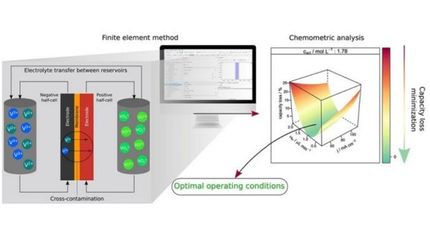Changing the Channel in Nanoelectronics
New computer simulations may help in the design of efficient molecular wires
Advertisement
Two types of trends can be identified in the length-dependent conductance of molecular wires, according to Chinese scientists. In an article published in ChemPhysChem, Jianwei Zhao and colleagues describe different length–conductivity relationships in molecular wires depending on the structures dominating the electron-transport channels. With the aid of computer simulations, the researchers were able to define a quantitative relation between the energy band gaps of different conjugated molecules and the attenuation factor — an important parameter that determines the distance over which charge can be conducted efficiently through a material. “The new results may be helpful in the design of molecular wires for nanoelectronic applications”, the researchers say.
An important step in the development of electronic devices at the single-molecule level is the understanding of charge transport through individual molecular wires. In the macroscopic world, the resistance of a metallic wire increases linearly with length. But the situation is completely different for nanometer-long molecular wires, which may have diverse molecular structures leading to different electron-transport behaviors.
To address this problem, Zhao and co-workers investigated the length dependence of the conductance through several conjugated organic molecules, thereby identifying two different trends depending on the molecular structure: a single-channel conductance and a multichannel one. The researchers found that in the case of single-channel molecules such as oligothiophene (an organic semiconductor), the conductance decays rapidly with the length, following an exponential law. However, if the molecular wires have multichannels, the decay of conductance shows a different behavior. For example, the conductance of short porphyrin-based chains decays almost linearly with length, making this type of conjugated molecules particularly promising for applications as molecular wires, according to the authors.
The simulations carried out by the Chinese team have also allowed them to find a way to determine the attenuation factor—an important indicator of electron transport through a molecular wire—directly from the energy band gap of the organic compound. The researchers believe that this observation could be of use in reaching one of the ultimate goals in molecular electronics: the design of robust molecular wires with efficient electron transport over long distances.
Original publication: Jianwei Zhao et al.; "The Diversity of Electron-Transport Behaviors of Molecular Junctions: Correlation with the Electron-Transport Pathway"; ChemPhysChem 2010, 11, No. 9.
Other news from the department science

Get the chemical industry in your inbox
By submitting this form you agree that LUMITOS AG will send you the newsletter(s) selected above by email. Your data will not be passed on to third parties. Your data will be stored and processed in accordance with our data protection regulations. LUMITOS may contact you by email for the purpose of advertising or market and opinion surveys. You can revoke your consent at any time without giving reasons to LUMITOS AG, Ernst-Augustin-Str. 2, 12489 Berlin, Germany or by e-mail at revoke@lumitos.com with effect for the future. In addition, each email contains a link to unsubscribe from the corresponding newsletter.
Most read news
More news from our other portals
Last viewed contents
ATC_code_V01
ATC_code_A05
ATC_code_C01
ATC_code_N01
ATC_code_H04
ATC_code_A09
Supramolecular_electronics
Electromagnetic_compatibility

Navarra de Tratamiento del Agua, S.L - Barbatain - Navarre, Spain

































































